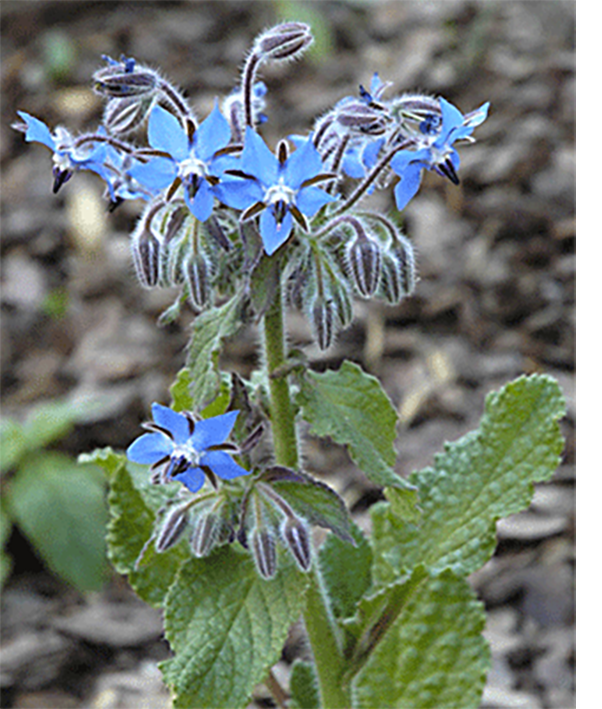 Borage Borago
officinalis,
plant in flower..
Borage Borago
officinalis,
plant in flower..
Welcome to the summary page for FabulousFusionFood's Herb guide to Borage along with all the Borage containing recipes presented on this site, with 10 recipes in total.
e This is a continuation of an entire series of pages that will, I hope, allow my visitors to better navigate this site. As well as displaying recipes by name, country and region of origin I am now planning a whole series of pages where recipes can be located by meal type and main ingredient. This page gives a listing of all the Cornish recipes added to this site.
These recipes, all contain Borage as a major herb flavouring.
Borage, Borago officinalis, (also known as Echium amoenum, Beebread, Bugloss, Burrage and Starflower) is an annual herb belonging to the Boraginaceae (borage or forget-me not) family. The plant originated in Syria but has been naturalized throughout most of Europe, North Africa and Iran.
Normally it grows to about 90cm in height and is distinguished by having bristly hair that covers its stems and bear alternative leaves about 10cm in length. The plant's most striking attributes are its flowers which are either blue or pink in hue and bear five small distinctly pointed petals (hence the name 'starflower'). It reproduces by prolific self-seeding and will grow year-on-year where it was first planted.
The leaves and flowers of this plant are eaten, especially in Central Europe. The leaves have a pronounced cucumber-like flavour and are used in salads and soups. They are also used in to make the German Frankfurter Grüne Sauce in conjunction with parsley, chervil, chives, cress, sorrel, burnet. The flowers have a sweet honey-like taste and are often used to decorate desserts and salads. They are also frozen in ice-cubes to decorate cocktails.
It should be noted that the leaves contain small amounts (10 ppm of dried herb) of the liver-toxic pyrrolizidine alkaloids: intermedine, lycopsamine, amabiline and supinine; though this is generally too little to be toxic in humans.
The English name, broage derives, via French and Spanish from the Medieval Latin borrago. The Medieval Latin is, itself, a borrowing from Arabic, and may come from Andalusian Arabic abu buraq 'father of sweat' (standard Arabic abu araq [أبو عرق]) [borage leaves were included in diaphoretic medicines] or from abu huras 'father of roughness', for the rough leaf surface.
e This is a continuation of an entire series of pages that will, I hope, allow my visitors to better navigate this site. As well as displaying recipes by name, country and region of origin I am now planning a whole series of pages where recipes can be located by meal type and main ingredient. This page gives a listing of all the Cornish recipes added to this site.
These recipes, all contain Borage as a major herb flavouring.
Borage, Borago officinalis, (also known as Echium amoenum, Beebread, Bugloss, Burrage and Starflower) is an annual herb belonging to the Boraginaceae (borage or forget-me not) family. The plant originated in Syria but has been naturalized throughout most of Europe, North Africa and Iran.
Normally it grows to about 90cm in height and is distinguished by having bristly hair that covers its stems and bear alternative leaves about 10cm in length. The plant's most striking attributes are its flowers which are either blue or pink in hue and bear five small distinctly pointed petals (hence the name 'starflower'). It reproduces by prolific self-seeding and will grow year-on-year where it was first planted.
The leaves and flowers of this plant are eaten, especially in Central Europe. The leaves have a pronounced cucumber-like flavour and are used in salads and soups. They are also used in to make the German Frankfurter Grüne Sauce in conjunction with parsley, chervil, chives, cress, sorrel, burnet. The flowers have a sweet honey-like taste and are often used to decorate desserts and salads. They are also frozen in ice-cubes to decorate cocktails.
It should be noted that the leaves contain small amounts (10 ppm of dried herb) of the liver-toxic pyrrolizidine alkaloids: intermedine, lycopsamine, amabiline and supinine; though this is generally too little to be toxic in humans.
The English name, broage derives, via French and Spanish from the Medieval Latin borrago. The Medieval Latin is, itself, a borrowing from Arabic, and may come from Andalusian Arabic abu buraq 'father of sweat' (standard Arabic abu araq [أبو عرق]) [borage leaves were included in diaphoretic medicines] or from abu huras 'father of roughness', for the rough leaf surface.
The alphabetical list of all Borage recipes on this site follows, (limited to 100 recipes per page). There are 10 recipes in total:
Page 1 of 1
| Almond Cupcakes with Candied Borage Flowers Origin: Britain | Candied Borage Flowers Origin: Britain | To Candy Flowers for Sallets, as Violets, Cowslips, Clove-gilliflowers, Roses, Primroses, Borrage, Bugloss, &c. Origin: Britain |
| Borage Flower Soup Origin: Britain | Eowtes of Flessh (Herbs Like Flesh) Origin: England | To pickle any kind of Flowers. Origin: Britain |
| Borage Soup Origin: Britain | Hebolace Origin: England | |
| Borage Soup II Origin: Britain | Salat (Salad) Origin: England |
Page 1 of 1